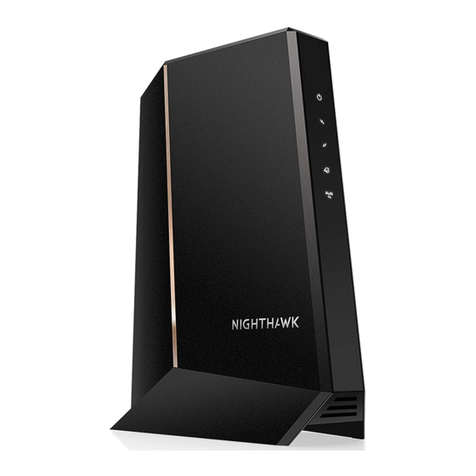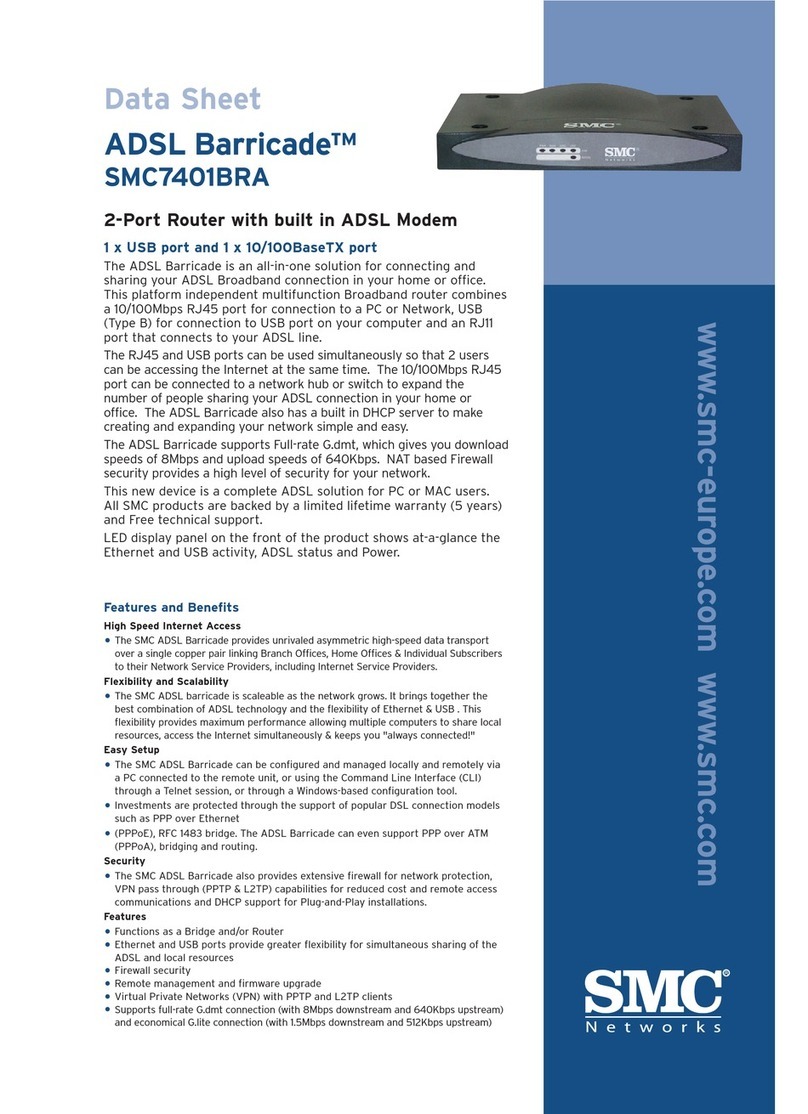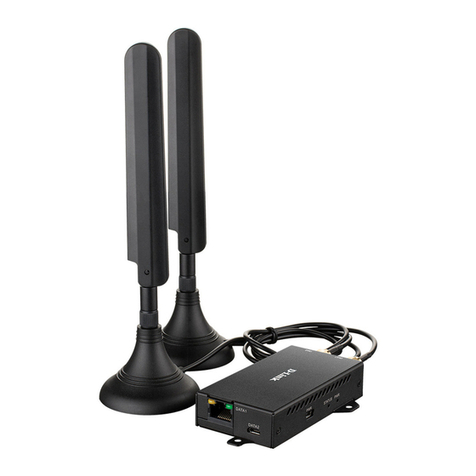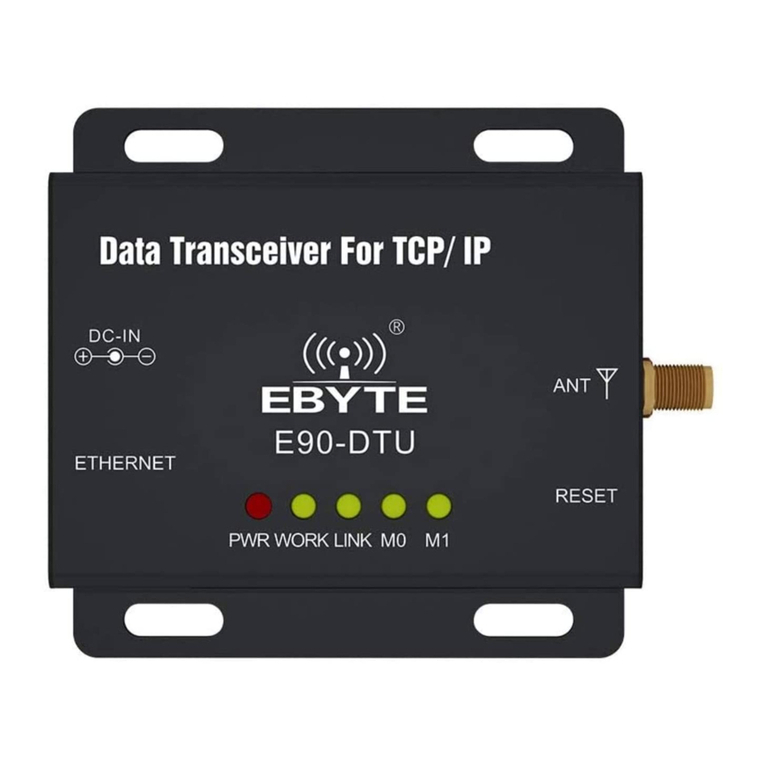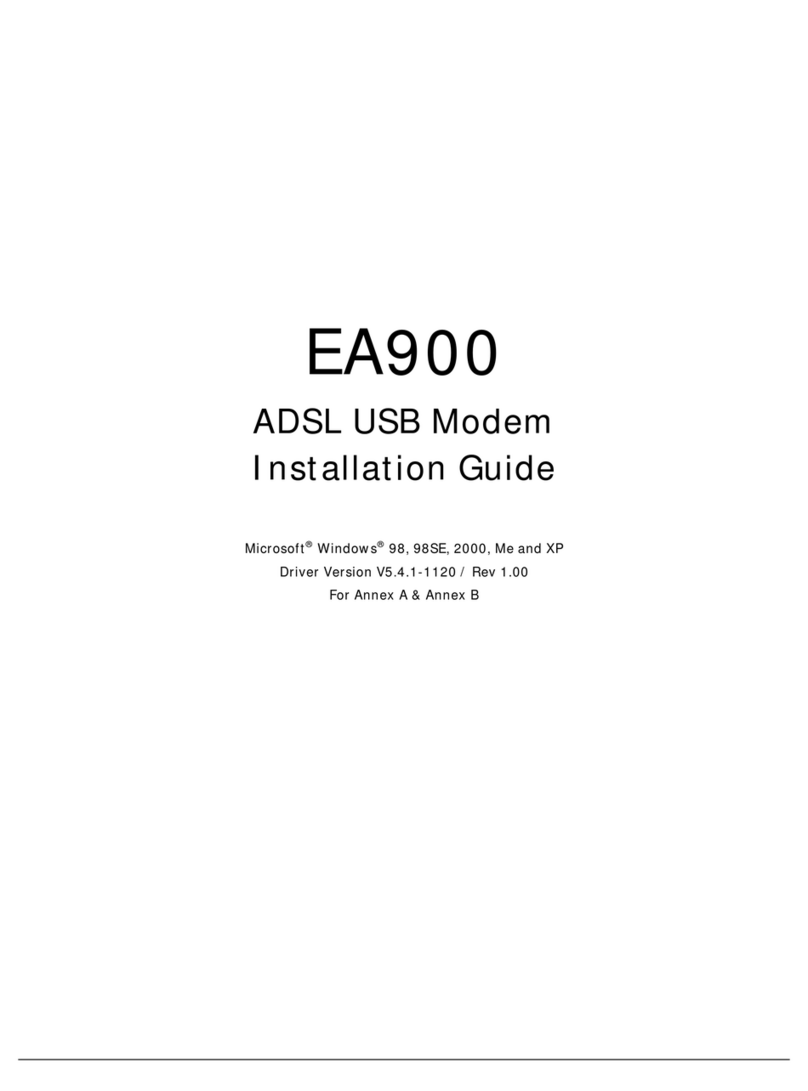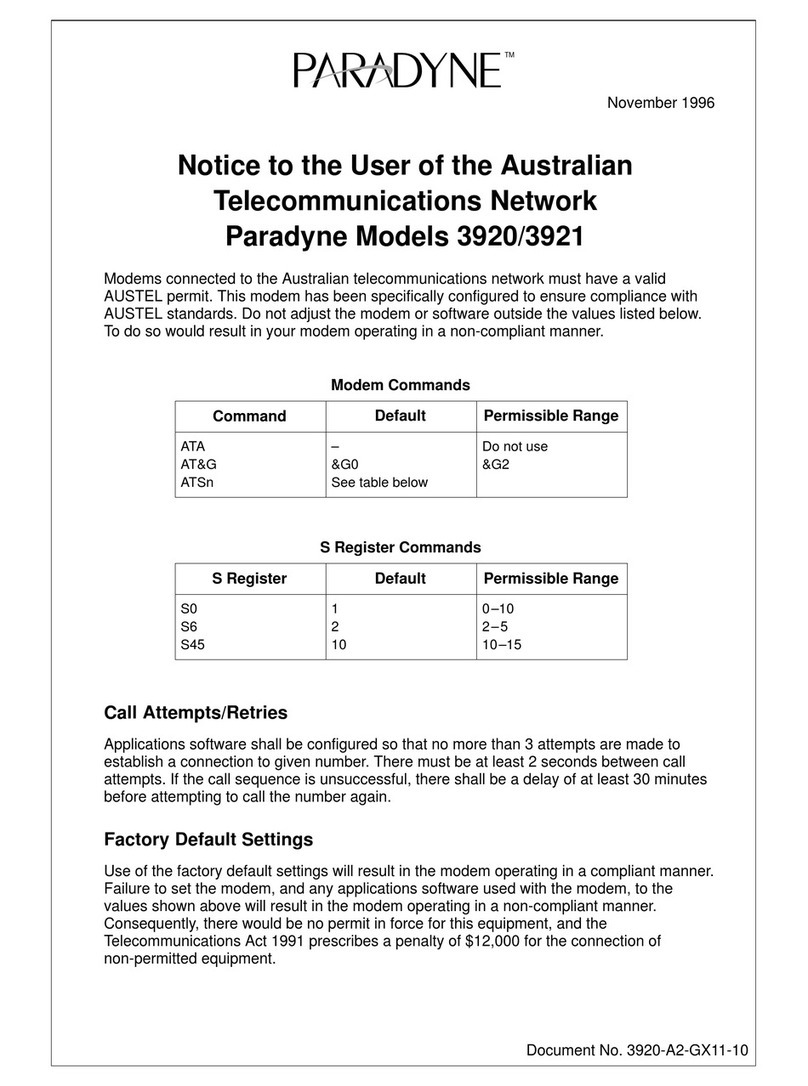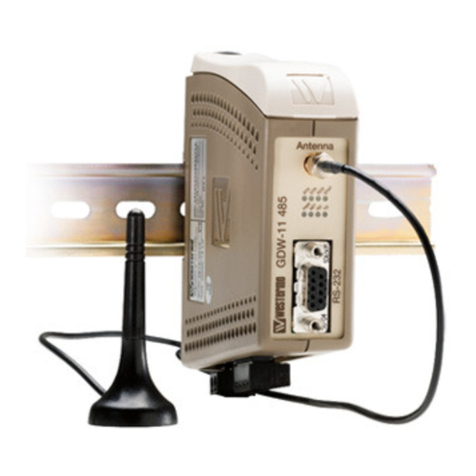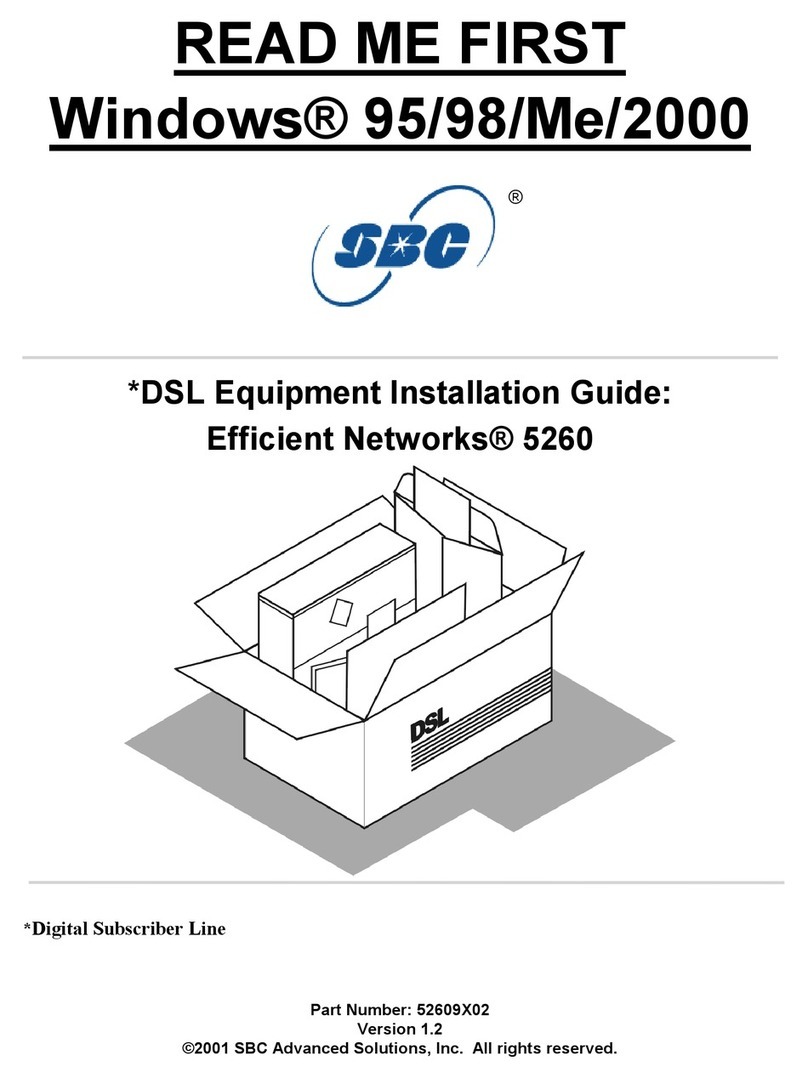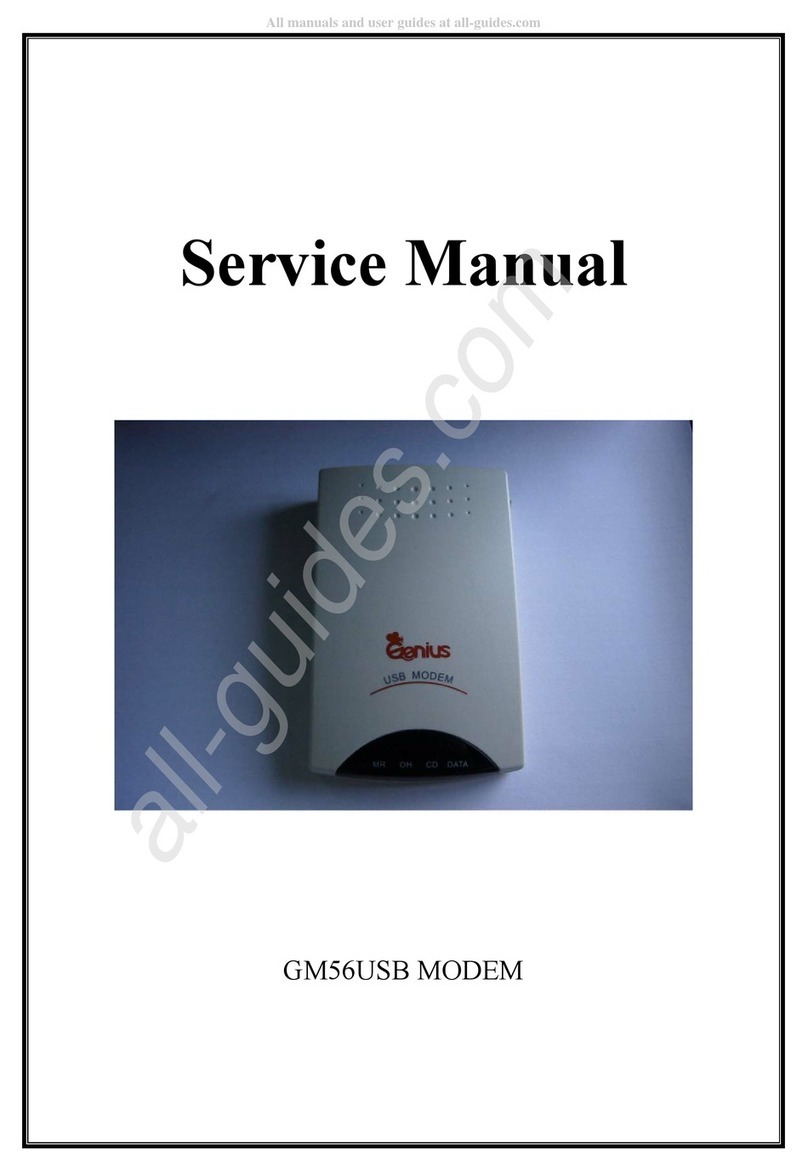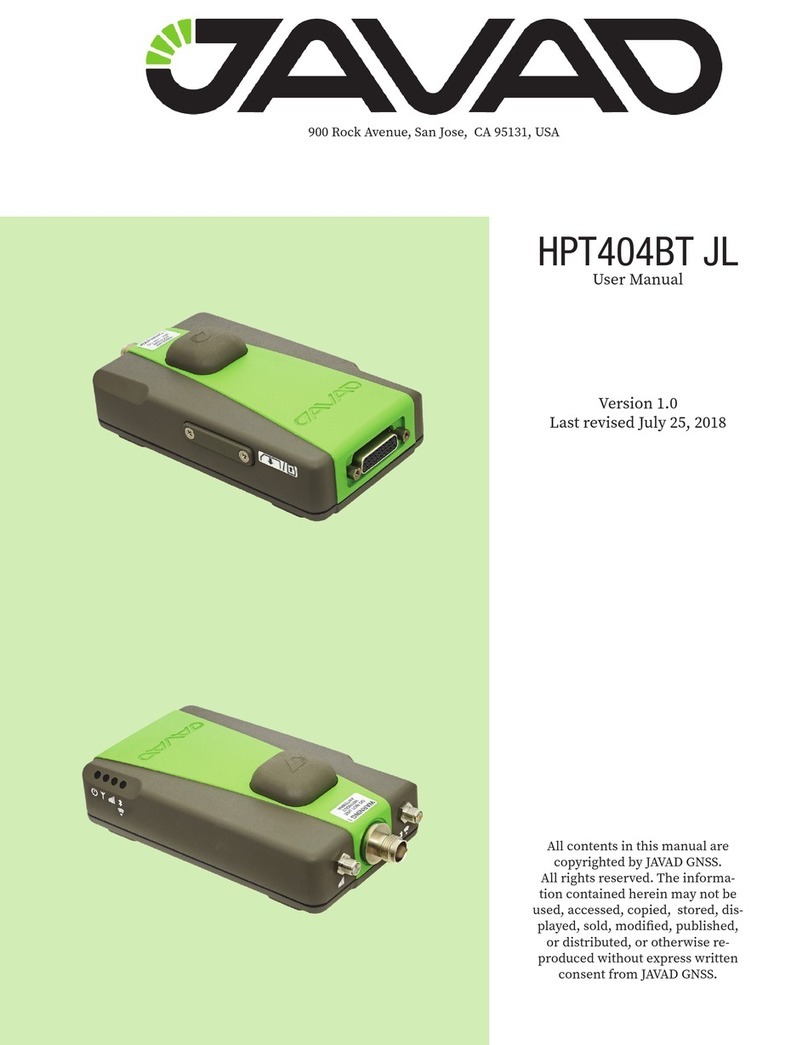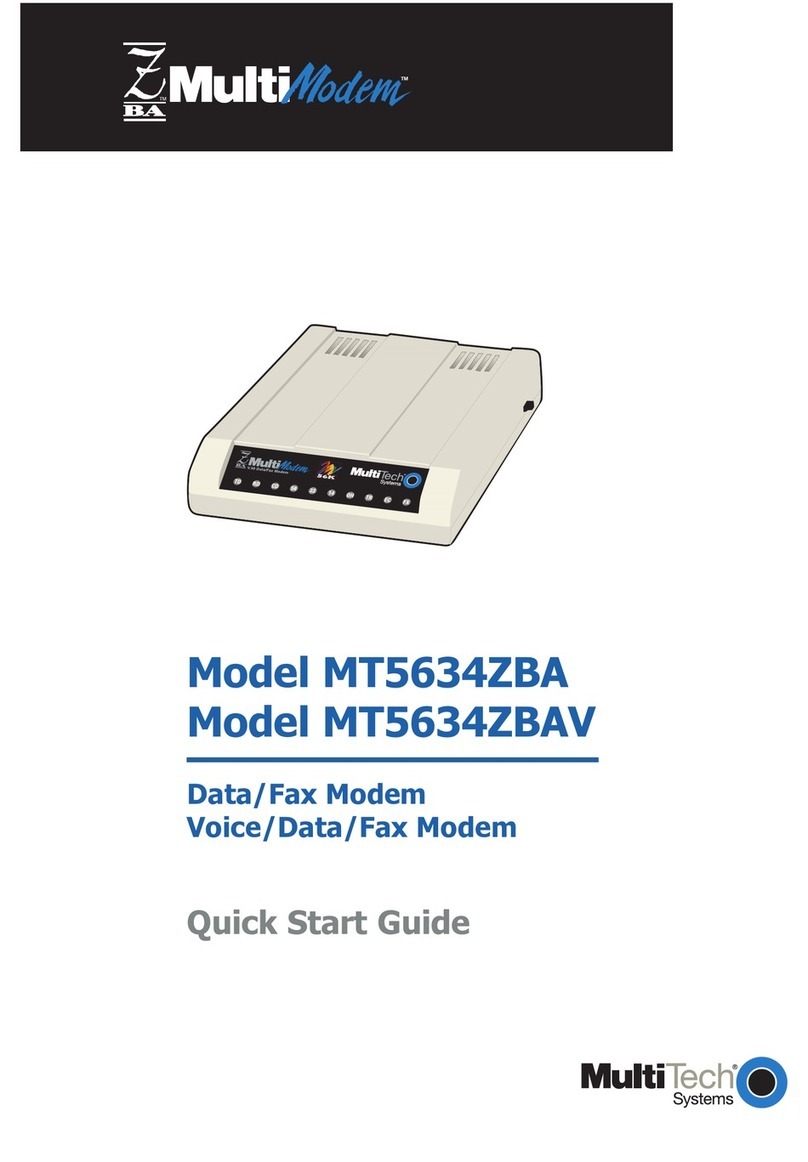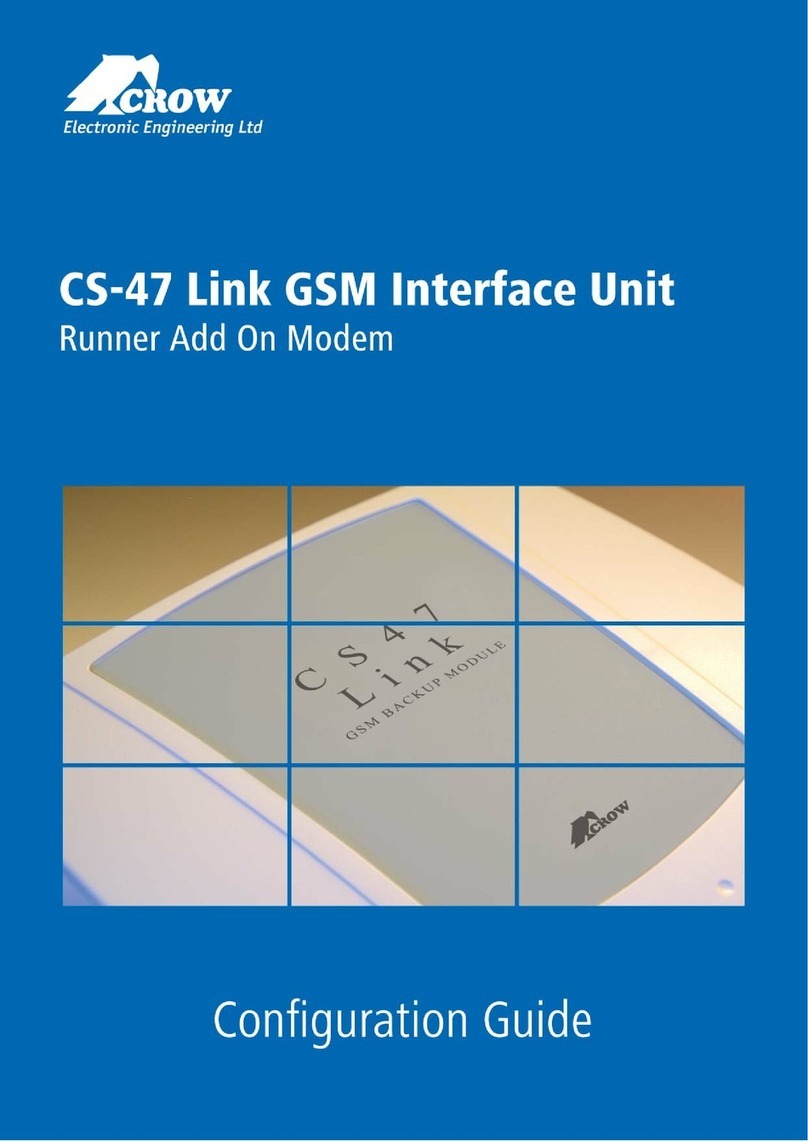Data-Linc Group SRM6200E-SLC User manual

USER GUIDE
I
NDUSTRIAL
D
ATA
C
OMMUNICATIONS
It is essential that all instructions contained in the User Guide are followed precisely to ensure proper operation of equipment.
SRM6200E-SLC
Frequency Hopping Spread Spectrum
Ethernet Radio Modem

DATA-LINC GROUP
PN161-09990-002C
Product User Guide
FCC Notification
This device complies with part 15 of the FCC rules. Operation is subject to the following conditions:
1) This devicemaynot causeharmfulinterference and
2) This devicemustaccept any interferencereceived,including interferencethat may
causeundesired operation.
The device must be operated as supplied by Data-Linc Group.Any changes or modifications made to the
devicewithout theexpress writtenapproval ofData-Linc Groupmay voidthe user’sauthorityto operatethe
device.
Caution: This device has a maximum transmitted output power of 955 mW. It is required that the
transmit antenna be kept at least 23 cm away from nearby persons to satisfy FCC RF exposure
requirements.
Note: This equipment has been tested and found to comply with the limits for a ClassAdigital device, pursuant
topart 15 of the FCC Rules. These limits are designed to provide reasonable protection againstharmful
interferencein aindustrial installation.This equipmentgenerates, usesand canradiate radiofrequency energy
and, if not installed and used in accordance with the instructions, may cause harmful interference to radio
communications.However, thereis noguarantee thatinterference willnot occur in a particular installation.If
thisequipment doescause harmful interference to radio or television reception, which can be determined by
turning the equipment off and on, the user is encouraged to try to correct the interference by one or more of the
followingmeasures:
Reorientor relocatethereceiving antenna.
Increasethe separation betweentheequipment andreceiver.
Connect the equipment into an outlet on a circuit different from that to which the receiver is connected.
Consultthe dealeror anexperienced radio/TVtechnician for help.
Note: Wheneverany Data-Linc Group SRM series modem is placed inside an enclosure a label must be
placed on the outside of that enclosure which includes the modem’s FCC ID.
Thefollowing antennasare approved for use withData-Linc Group’s900 MHz series modems.
NOTE: Per FCC Rules, the maximum power allowed at the antenna is 4 Watts E.I.R.P.
900MHz Directional Antenna
Gain Manufacturer Manufacture Model Number Data-Linc Model Number
8.2 dBi Larsen YA6-900W A-YB
12.2 dBi Larsen YA0006 A-Y10B
900MHz Omni-Directional Antenna
Gain Manufacturer Manufacture Model Number Data-Linc Model Number
5.2 dBi Maxrad MAX-9053 A-OB
7.2 dBi Maxrad BMEFC8985HD A-O5B
0 dBi Ying Hao YH920801/AD-725-A-1 A-06/ADJ
0 dBi Centurion EXC-902-BN A-06BH-3S / 10S (**)
(**) This part number refers to an antenna kit(s). The 0 dBi refers to the antenna portion of the kit.
Note: The antenna used for this device must be professionally installed on a fixed-mounted permanent
outdoor structure for satisfying RF exposure requirements, including antenna co-location requirements
of1.1307(b)(3).

DATA-LINC GROUP
1
SRM6200E-SLCUser’sGuide
PN161-09990-002C
rev 3/29/04
Table of Contents Page
Introduction 3
Quick Start 4
ModemConfiguration 6
Main Menu Option (0): Set Operation Mode 8
Main Menu Option (1): Set Baud Rate 10
Main Menu Option (2): Edit Call Book 10
Main Menu Option (3): Edit Radio Transmission Characteristics 12
Main Menu Option (4): Show Radio Statistics 16
Main Menu Option (5): Edit Multi-Point Parameters 18
Main Menu Option (8): Password 21
ModemLocation 22
UsinganExternalAntenna 22
Modem Front Panel LED’s 23
Sample Data Communication Links 25
Technical Specifications 27
Troubleshooting 28
Technical Support 29
ReturnMaterialAuthorization 29
Contact Information 29
○○○○○○○○○○○○○○○○○○○○○○○○○○○○○○○○○○○○○○○○○○○○○○○○○○○○
○○○○○○○○○○○○○○○○○○○○○○○○○○○○○○○○○○○○○○○○○○○○○○○○○○○○
○○○○○○○○○○○○○○○○○○○○○○○○○○○○○○○○○○○○○○○○○○○○○○
○○○○○○○○○○○○○○○○○○○○○○○○○○○○○○○○○
○○○○○○○○○○○○○○○○○○○○○○○○○○○○○○○○○○○○
○○○○○○○○○○○○○○○○○○○○○○○○○○○○○○○○○○○○
○○○○○○○○○○○○○○○○○○○○
○○○○○○○○○○○○○○○○○○○○○○○○○○○○○○○○
○○○○○○○○○○○○○○○○○○○○○○○○○○○○
○○○○○○○○○○○○○○○○○○○○○○○○○○○○○○○○○○○○○○○
○○○○○○○○○○○○○○○○○○○○○○○○○○○○○○○○○○○○○○○○○○○○○○○○○
○○○○○○○○○○○○○○○○○○○○○○○○○○○○○○○○○○○○○○○○○○○
○○○○○○○○○○○○○○○○○○○○○○○○○○○○○○○○○○○○○○○○○○○
○○○○○○○○○○○○○○○○○○○○○○○○○○○○○○○○○○○○○
○○○○○○○○○○○○○○○○○○○○○○○○○○○○○○○○○○○○○○○○○○○○
○○○○○○○○○○○○○○○○○○○○○○○○○○○○○○○○○○○○○○○○○○○○○○○○○
○○○○○○○○○○○○○○○○○○○○○○○○○○○○○○○○○○○○○○○○○○○○○○○○
○○○○○○○○○○○○○○○○○○○○○○○○○○○○○○○○○○○○○○○○○
○○○○○○○○○○○○○○○○○○○○○○○○○○○○○○○○○○○○○○○○○○○○○○○

DATA-LINC GROUP
2PN161-09990-002C
rev 3/29/04
SRM6200E-SLCUser’sGuide

DATA-LINC GROUP
3
SRM6200E-SLCUser’sGuide
PN161-09990-002C
rev 3/29/04
Introduction
Data-LincGroup’sSRM6200E-SLC has beendesigned to mountin anAllen-Bradley SLC 500Slot Rack.The SRM6200E-
SLCtransceiver modem isahigh performance,wirelessradio modem designedforheavy-duty industrialdata
communicationsin the 902-928MHzlicense-free band.Itemploys advanced spreadspectrumfrequency hoppinganderror
detectiontechnology to achievevery reliable,noiseand interferenceimmuneoperation.Ahigh RFdatarateof 188kbpsand
superiorsensitivity provideultra reliable dataintegrity.TheSRM6200E-SLC hasa rated rangeof upto 25 miles(40 km)and
an installed range of up to 35 miles (56 km) in optimal conditions with line-of-sight and an omni directional antenna. This can
alsobe extended furtherwithrepeaters orhighergain antenna.
TheSRM6200E-SLC can beoperated inanumber ofdifferentmodes tosatisfya broadrange of communications
requirements.It canbeconfigured forpoint-to-point or multi-pointoperation withanunlimited numberof remote siteson a
singlemaster dependingon data throughputrequirements. Repeaterscan beused in thesystem toextend range and
eliminate dead RF zones that are blocked by obstructions.
An external antenna can be used with up to two hundred feet of coax. This provides a boost in signal strength and decreases
induced noise levels. With an external antenna, radio modems can be located inside buildings or metallic enclosures.
Equippedwith a10 Base-T Ethernetport, theSRM6200E-SLC is easilyconnected viastandard 10 Base-TCategory 5patch
cord(provided) toanAllen-Bradley SLC5/05 CPU ENET port,hubor anyother device equippedwith a 10Base-Tnetwork
interface.
TheUser Guide coversthe operating modesand configurations thatare available tousers of theSRM6200E-SLC. Italso
providesthe userwith bench testinginstructions, technicalinformation andspecifications.
In most applications, the SRM6200E-SLC comes pre-configured for the application in which it is going to be used. In most
casesno otherconfigurationis required.If you areunsure if themodem needsfurtherconfiguration, pleasecontact Data-Linc
Group.

DATA-LINC GROUP
4PN161-09990-002C
rev 3/29/04
SRM6200E-SLCUser’sGuide
Quick Start
TheSRM6200E-SLC comes pre-configuredforyour application (unlessotherwiserequested). In mostcases,configuration
settingsare notrequired.
Although each modem is tested before shipment, it is recommended that a bench test be done before the modem is
installed in its application.
In all applications, there is a master modem and one or more remotes. Some applications may also have one or more
repeaters. This “Quick Start” will assume that there is a repeater in the system. If there is not, ignore the parts that talk
aboutrepeaters, asthe remote modems should operatethe samewith or withoutrepeaters.
TheSRM6200E-SLCisavailable in threedifferent powerconfigurations:
• SRM6200E-SLC is a 12VDC powered device that is designed to take 12VDC in on the barrel jack on the front
panel.
•SRM6200E-SLC/BPis a24VDCpowered devicethat receives powerdirectly fromthe backplane anddoes not
need a separate power supply. Be sure that your 1746 chassis has a large enough supply — Data-Linc Group
recommends the use of the P-4 power supply chassis (a wall transformer power supply has been included for
bench testing purposes).
• SRM6200E-SLC/24Vis a24VDC powered devicethat isdesigned totake 24VDC inon theremovable screw
terminal connector on the front panel (please note the polarity: positive side marked “+” on the top if you are
supplying your own power).
Locate the modem labeled “Master” and connect its power supply to an appropriate 120VAC power source, then connect it
to the modem. The “P” LED should come on and stay on
Note: on all modems, the “RF Link” LED will come on for the first few seconds after power up.
Next, locate the modem(s) labeled “Repeater” and connect to power. The LED “P” and “RF Link” should come on and stay
on. Now locate the modem(s) labeled “Remote” and connect to power. The LED “P” and “RF Link” should come on and stay
on.The modems are now ready to carry Ethernet data.
Connectthe “Master” and“Remote” (or“Repeater/Remote”if yournetworkhas one)to the Ethernetequipment that hasbeen
pretestedfor operation. Thedevicehas beendesignedwith a crossoverswitch.The crossoverfunctioninterchanges the
transmitand receivepairsremoving theneedfor acrossover cable incertain situations.
The SRM6200E-SLC crossover switch has been factory set in the crossover position. If the system is connected and the
LAN link LED is not lit, the crossover switch (SW3- Diagram 3, pg. 24) may need to be moved to the straight through
position.

DATA-LINC GROUP
5
SRM6200E-SLCUser’sGuide
PN161-09990-002C
rev 3/29/04
Tochange thecrossover switch removethe SRM6200E-SLC fromtheAllen-BradleySLC500 Slot Rack.Underthe edgeof
the enclosure is a black and silver slide switch (S3- Diagram 3, page 24). If connecting to an Ethernet hub, the crossover
switch should be set in the straight through (left) position. If connecting to a PC, PLC or most other Ethernet interface
equippeddevices, thecrossover switch shouldbe setinthe crossover(right) position.
Note: TheSRM6200E-SLC willnot support“Peer toPeer” communications. The equipment thatis attachedto the
SRM6200E-SLCmust becapableof operatingin a “Master(host) toRemote” network
.
It is recommended that a “Ping” test be done at this point. This can be done in either direction, but remember that only a
“Master to Remote” or “Remote to Master” connection can be established through the modems.Also note that because of
the MAC filtering done by the modems, if you take a piece of Ethernet equipment on one side of the SRM6200E-SLC
networkand move it to the other sideof saidnetwork, youmust power down both the “Master” and the effected“Remote” in
order to re-establish connectivity through the modems. If powering down the modem is not practical to the applications, the
modems will rebuild the MAC filter table in approximately six minutes and communications should return. Once a successful
“Ping” test has been done, the modems are ready for communication. If the “Ping” test was not successful, please refer to
the trouble shooting section of this manual or contact Data-Linc Group tech support for assistance.

DATA-LINC GROUP
6PN161-09990-002C
rev 3/29/04
SRM6200E-SLCUser’sGuide
Configuration
Inmost cases,the SRM6200E-SLCcomes pre-configured fromthe factory. However, itmay sometimes be necessary to
changethe configuration.Most parameters arechanged inthe radiosection of themodem althoughthere are a few settings
that are set using switches. If you are not sure if you need to change the configuration of the SRM6200E-SLC, you probably
don’t.Please contact Data-LincGroup for furtherinformation if youare unsure aboutyour configuration.
Switch Settings
To access the switches, remove the modem from the SLC Rack. The switch bank (SW1-Diagram 3, pg. 24) is located in the
center of the large PCB.
Note: Leave switch positions 4, 5 and 6 at factory setting of off unless otherwise directed by Data-Linc Group.
Changingthese switches requiresaradio parameterschange.
MAC Filtering Function
Alldevices capableof generating Ethernet traffichave aMAC (MediumAccess Control)address. This address is usedin the
communicationsof Ethernetdata.
The SRM6200E-SLC is factory set to perform MAC level filtering. This means that it learns all the MAC addresses from the
LAN it is connected to, and only forwards data packets across the radio links which are destined for addresses located
across the radio link. The MAC filtering function is enabled by setting switch (SW2-Diagram 3, pg.24) to the on position.
The MAC address table can store up to 10,000 addresses. Each entry to the table has a lifetime of six minutes after which
the address is deleted. This dynamic table building allows for the possibility of stations being removed from the LAN. The net
result of this filtering functionality is the reduction of unnecessary network traffic across the radio link.
Note: ManyEthernet networks have data packets that arenot coveredby theMAC filterfunction (broadcastpackets
forexample). These packetscan occupy tremendousamount of thenetwork’s bandwidth andoverwhelm the
SRM6200E-SLCsection ofthe network. Ifthe SRM6200E-SLC’sare goingto be installedwhere theyare linked to
anopen network(on officenetwork, etc.),a properlyconfigured routeror switchshould beinstalled toprotect the
modemsfrom excessivedata traffic. Ifyou areunsure aboutyour network, pleaseconsult withyour network
administrator.

DATA-LINC GROUP
7
SRM6200E-SLCUser’sGuide
PN161-09990-002C
rev 3/29/04
Radio Parameter Configuration
TheSRM6200E-SLC allowsyou to set several parameterstosuit yourparticularapplication.Alladjustmentsare done
throughthe SRM6200E-SLCsetup program, a user interfacethat eliminatesthe need for setup diskettesor customsoftware.
To access the configuration menu, connect the radio modem’s configuration port to any terminal program with port settings of
19.2Kbaud, 8 data bits, no parity and one stop bit. With the modem connected to the PC running the terminal program,
pressthe Configurebutton. While anyterminal programwill work, examplesfor thismanual were generatedusing the
MicrosoftWindows2000application “HyperTerminal.”
Note: Whenusing HyperTerminal, set Handshakingto noneand usea standard straight throughcable. Ifyou are
using something other than HyperTerminal, it may be necessary to use a cable that has pins 4 and 6 connected
togetheron themodemside ofthecable. ContactData-Linc for furtherinformation.
Table 1: Terminal Settings
Whenthe setup programis invokedtheRF “IN”LEDon theSRM6200E-SLC front panelwill flash oncewhen the Configure
button is pressed and the RF “Link” LED will remain on for the entire time the radio modem is in setup mode.
Themain menuprovides the radiomodem’s uniquecallbook numberand the setof choicesfor editing theoperational
parametersandviewingtheperformance data.
Figure 1: Main Menu
retemaraP gnitteS
etaRduaB00291
stiBataD8
ytiraPenoN
stiBpotS1
lortnoCwolFenoN

DATA-LINC GROUP
8PN161-09990-002C
rev 3/29/04
SRM6200E-SLCUser’sGuide
Main Menu Option (0): Set Operation Mode
When item (0) is selected, the Operation Mode Menu appears as shown in figure 2. The Operation Mode option is used to
designatethe methodin which theparticular SRM6200E-SLCwill be used.The SRM6200E-SLCoperates in amaster to
remote configuration; therefore, any radio modems that are intended to operate together must be set up as such. In a point-
to-point setup, either the Master or Remote may be used on either end of the communications link. One consideration when
setting up the radio modems is that a number of parameters are controlled by the settings in the Master; therefore, you may
wish to deploy the Master on the communications end where you will have easier access to the radio modem.
Figure 2: Mode Menu
Shownbelow are examplesettings. Pleasereferto suppliedconfigurationsheets foryour modem’s configuration.
(0) Point-to-point Master
TheSRM6200E-SLC operates ina master/remote configuration.When designatedasa masterinpoint-to-point mode,
the radio modem will call any or all remotes it is instructed to call in the call book. The Master determines the settings
usedfor allRadio Transmission Characteristics(except power),regardless ofthe settings inthe remotesand/or
repeaters.
(1) Point-to-Point Remote
When set up as a point-to-point remote, an SRM6200E-SLC will communicate with any master in its call book, either
directly or through one or two repeaters. When functioning as a remote, the Entry to Call feature in the radio modem’s
call book (Figure 3) is not operational. The remote will communicate with any master on the list that calls.
(2) Point-to-Multi-Point Master
The SRM6200E-SLC may be set to run in multi-point mode, which allows one master to simultaneously be in
communicationwith numerousremotes.Apoint-to-multi-point master willcommunicate onlywith other radiomodems
designatedaspoint-to-multi-point remotesorpoint-to-multi-point repeaters.
(3) Point-to-Multi-Point Remote
Setting (3) allows the radio modem to operate as a remote in a multi-point network.
Pleaserefer tothesection entitledmulti-point operation, formore information onrunning amulti-point network.

DATA-LINC GROUP
9
SRM6200E-SLCUser’sGuide
PN161-09990-002C
rev 3/29/04
(4) Point-to-Point Remote/Repeater
Option 4 allows you to designate the radio modem to act as either a remote or a repeater, depending upon the
instructions received from the master for the specific communications session. When a radio modem is placed in an
ideal location, this setting offers the flexibility of using that radio modem as an end point in the communications link
(remote)or to extendthe linktoa furtherpoint(repeater).These functions arenot, however, availablesimultaneously(the
radio modem cannot act as both a remote and a repeater at the same time).
Note: Configuredas arepeater,a radiomodem has nosecurity featuresas explained below. When aradio modem
is designated as a Point-to-Point Remote/Repeater, it will allow any master to use it as a repeater.
(5) Point-to-Point Repeater
SRM6200E-SLC radio modems allow the use of up to two repeaters in a communications link, significantly extending the
operatingrange. When designated as a repeater, aradio modembehaves asa pass-throughlink.All settings for the call
book, baud rates, and radio transmission characteristics are disabled.Arepeater will connect with any master that calls
it (the repeater must still be set up in the master’s call book).
Theuse ofone repeater ina communicationslink will reducethe topdata throughput availablewhen comparedtoa
directmaster toremote link (generallyon theorder of 50%).The throughputdoesnot decreasefurther if tworepeaters
areused.
(6) Point-to-Point Remote/Master Switchable
Mode 6 is not applicable to the SRM6200E-SLC radio modems.
(7) Point-to-Multi-Point Repeater
Setting (7) allows the radio modem to operate as a repeater in a multi-point network.
Pleaserefer tothesection entitled,multi-point operation, formore informationonrunning amulti-point network.
(F) Ethernet options
This selection is factory set and should not be changed.

DATA-LINC GROUP
10 PN161-09990-002C
rev 3/29/04
SRM6200E-SLCUser’sGuide
Main Menu Option (1): Set Baud Rate
The baud rate setting affects the interface between the radio and Ethernet sections of the modem.All of the settings are
factory set and should not be changed.
Main Menu Option (2): Edit Call Book
TheCall Bookis aninnovative feature inthe SRM6200E-SLCthat offersboth security and flexibility inuse. TheCall Book
accomplishesthis byallowing theuser to determinewith whichother SRM6200E-SLCsa given radiomodem will
communicate, based on the call book numbers for both the Master and Remote. The radio modem’s call book number is
encodedin themicroprocessor and identifiedon alabel onthe modem. Theinstructions providedin thissection are forpoint-
to-point mode only. Use of the Call Book for multi-point systems is explained later in this chapter. For two SRM6200E-SLC
radiomodems tocommunicate in point-to-point mode, threeevents mustoccur:
1. The call book number for the Master must be listed in the Remote’s Call Book.
2. The call book number for the Remote must be listed in the Master’s Call Book.
3. The Master must be programmed to call the remote.
As shown in figure 3, the Call Book allows users to set up a list of up to 10 SRM6200E-SLCs to communicate with,
designate up to 2 repeaters to be used in communicating with a given radio modem, and tell the Master which remote to call.
To direct the Master to call a remote, the Remote must be in the Call Book Menu. Aspecific remote may be called by
entering(C) atthe prompt, followedby themenu numbercorresponding to thatremote.To callany availableremote inthe
list, the user should enter C and thenA(forAll).
Note: To call a remote through one or two repeaters, you must call that remote directly (as opposed to using the
CallAll option). When CallAll is selected, the Master is not able to connect with any remotes through repeaters.
This is because the Master calls every remote in the list when instructed to call all and will connect with the first
remote to respond. When calling through a repeater, the Master must first call that Repeater and establish a
communications link with it prior to making contact with the Remote.
Figure 3: Call Book Menu

DATA-LINC GROUP
11
SRM6200E-SLCUser’sGuide
PN161-09990-002C
rev 3/29/04
Entering or Modifying Numbers in the Call Book
Entering or modifying call book numbers in the Call Book is a straightforward process. When in the Call Book menu select
the entry number (0 – 9) you wish to edit. You will be prompted for the new number (formatting is automatic, you do not need
to enter the dash). Once the number is entered (unless it is 000-0000) you will be asked for the call number of the first
repeater to be used. If no repeater is to be used, enter the escape key; your entry will be complete and you will be back in
the Call Book menu screen. If you enter a repeater number you will then be prompted for the call number of the second
repeater to use. If a second repeater is being used, enter the call number at this time; if not then enter the escape key. Once
again, the radio modem will retain your entries, as shown in the updated Call Book menu screen.
Note: It is important that the Call Book slots (0 – 9) are filled sequentially beginning with 0, the first slot in the book.
Callbook numbersdonot needto be enteredin numerical order;however, there mustnot be any000-0000 numbers
in the middle of the list of good call book numbers. The reason for this is that when a master is instructed to CallAll
available remotes, it will call all remotes listed until it reaches the number of 000-0000. If a valid call book
number is entered after the all zero number, it will not be recognized as a valid number to be called by the Master.
Edit Call Book in Multi-Point Systems
In a multi-point system the Remotes and Repeaters are not listed in the Master’s Call Book. When establishing such a
system, it is necessary only to have the Master’s call book number in each Remote’s and Repeater’s Call Book, and to have
each repeater’s call book number in the Call Book of each remote which may potentially communicate through it.
The following example shows the Call Books of a multi-point system comprised of a master, repeater and remote in which
the Remote can communicate either through the Repeater or directly to the Master:
Multi-PointMaster Call Book(Unit Callbooknumber 555-0001)
No call book number entries are necessary in the Master’s Call Book
The Master’s Call Book may be programmed to call any entry
Multi-PointRepeater Call Book(UnitCall book number555-0002)
yrtnErebmuN1retaepeR2retaepeR
)0(0000-000
)1(0000-000
yrtnErebmuN1retaepeR2retaepeR
)0(1000-555
)1(0000-000
Multi-PointRemote Call Book(Unit Call booknumber555-0003)
yrtnErebmuN1retaepeR2retaepeR
)0(1000-555
)1(2000-555
)2(0000-000

DATA-LINC GROUP
12 PN161-09990-002C
rev 3/29/04
SRM6200E-SLCUser’sGuide
Main Menu Option (3): Edit Radio Transmission Characteristics
When option (3) is selected in the main menu, the screen in figure 4 appears, which allows the user to modify the radio
transmission characteristics of the radio modems.As stated in the warning, these parameters are for the experienced user
whohas agood understanding ofthe principlesof radiodata transmission. Theyshould bechanged onlyafter consulting this
manual.
It is important to note that the radio parameters between any radio modems in communication will be determined by the
settings for the Master (except when in multi-point mode, see (4) RF Data Rate and (5) RF Power below). While the settings
maybe modifiedforthe Remote(s)and/or Repeaters, theywill be overriddenby theMaster’sparameters.
Note: For most Ethernet applications, these settings are already optimized. Please consult with Data-Linc Group
beforemakingchanges.
Figure 4: Radio Parameters Menu
Shownbelow are examplesettings. Pleasereferto suppliedconfigurationsheets foryour modem’s configuration.
(0) FreqKey
Selection (0) in the Radio Parameters menu allows the user to modify the hopping patterns of the radio modems to
minimize the interference with other SRM6200E-SLC radio modems in operation in the area. For instance, if there were
10 pairs of SRM6200E-SLCs in operation within a factory or refinery, changing the Frequency Key would ensure that
they would not jump onto the same frequencies at the same time for the same length of time.
There are 15 choices available for the Frequency Key (0-9 andA-E). It is recommended that a list be maintained of the
settings for each master to ensure that each is set to a different hopping pattern.
(1) Max Packet Size and (2) Min Packet Size Selections
(1) and (2) allow the user to designate the size of the packets (in bytes) used by the radio modem in its communications
link. This may be of particular value when using the SRM6200E-SLC with different communications software packages;
you may find that throughput is optimized when packet sizes are restricted by the radio modem.
Packet size is determined by a combination of the settings entered by the user and the RF Data Rate. In addition, the
Max Packet Size is a function of the setting selected for the Min Packet Size. Tables 2, 3 and 4 provide the packet
sizes for each different combination of settings.

DATA-LINC GROUP
13
SRM6200E-SLCUser’sGuide
PN161-09990-002C
rev 3/29/04
Table 2: Minimum Packet Size Settings (bytes)
gnitteS eziStekcaPniM
2=etaRataDFR gnitteS eziStekcaPniM
3=etaRataDFR
06108
112121
262261
323302
473442
524582
684623
735763
885804
946944
Table 3: Maximum Packet Size Settings where RF Data Rate=3
0 1 2 3 4 5 6 7 8 9
084204652788401021631251
1218244066729801421041651
2612384460869211821441061
30263258648001611231841461
44204652788401021631251861
58244066729801421041651271
62384460869211821441061671
763258648001611231841461081
804652788401041631251861481
944066729801421041651271881
MaximumSetting
MinimumSetting

DATA-LINC GROUP
14 PN161-09990-002C
rev 3/29/04
SRM6200E-SLCUser’sGuide
0 1 2 3 4 5 6 7 8 9
051638597001121341461581602
102243648501721841961091212
262748609111231351571691712
313254759611731951081102222
4638597001121341461581602822
5243648501721841961091212332
6748609111231351571691712832
7254759611731951081102222442
88597001121341461581602822942
9364859721841961091212332452
(3) Xmit Rate
There are two settings for the Transmit Rate parameter. For normal operation, the SRM6200E-SLC should be set at
Transmit Rate 1. Transmit Rate 0 is useful to qualitatively gauge signal strength. When set to Transmit Rate 0 the radio
modems will transmit data back and forth continuously, and the strength of the signal may be gauged by viewing the
“Show Radio Statistics” option.
Due to the fact that the radio modems transmit continuously when Transmit Rate is set to 0 (whether or not they have
data to send) they use radio frequency spectrum unnecessarily. Therefore,Transmit Rate 0 should be used only as a
diagnostic tool and not for normal operation.
(4) RF Data Rata
The SRM6200E-SLC has two settings for the RF Data Rate (the speed that the modems talk to each other). Setting 2
should be used when the radio modems are close together and data throughput is to be optimized. Setting 3 should be
used when the radio modems are farther away and a solid data link is preferred over data throughput.
Note: The RF Data Rate setting must be identical for all units in the system.Any radio modem with a different RF
Data Rate than the master will not establish a communication link.
MinimumSetting
MaximumSetting
Table 4: Maximum Packet Size Settings where RF Data Rate=2

DATA-LINC GROUP
15
SRM6200E-SLCUser’sGuide
PN161-09990-002C
rev 3/29/04
(5) RF Xmit Power
The SRM6200E-SLC offers users the ability to modify the Transmission Power of the radio modem. There
are 10 power settings available (1-10) which are roughly linear. Therefore a setting of 10 is full power or (1 Watt) and 1 is
10% power (or 100 mw). The following guidelines should be followed when setting the RF Transmission Power:
Table 5: Power Transmit Settings
gnitteS leveLrewoP nehWdesU
3-1woL ehtnihtiwgnitareposmedomoidarfosriapforiaP
.smoorgninojdaroemas
6-4muideM gnitareposmedomoidarforiapenonahteroM
.ytilicafemasehtihtiw
01-7lluF.ytilicafadnoyebgnidnetxenoitarepolamroN
(6) Remote Security
With option 6 the user may disable the radio modem’s security so it will accept a call from any other SRM6200E-SLC.
The default setting is 0 where security is enforced (the caller’s call book number must be in the Remote’s Call Book).
With a setting of 1 security is disabled.
(7) RTS to CTS
This setting is not applicable to the SRM6200E-SLC and should not be changed from the factory setting (the factory
setting is 0)
(8) Retry Time Out
The Retry Time Out parameter allows the use to determine when a remote will drop a connection to a master or repeater
in multi-point mode. The default setting is 255, meaning that if one packet in 255 from the Master is sent successfully to
the Remote it will maintain a link.The lowest setting is 8, at which a remote will drop a connection much faster.
The Retry Time Out parameter is useful when a multi-point system is used with a moving master or remotes.As the link
gets weaker, a lower setting will allow a remote to drop it’s link and search for a stronger connection.
While intended primarily for multi-point systems, the Retry Time Out parameter may also be modified in point-to-point
systems. In point-to-point mode the Retry Time Out should not be set to a value of less than 151.
(9) Lowpower Mode
The Lowpower Mode is not applicable to the SRM6200E-SLC. This setting should not be changed.
(A) High Noise
Use the menu to indicate if the modem will be operated in an environment with a high degree of radio noise and
interference.
With a setting of 1, the rejection of interference is improved, at the cost of reduced range and/or throughput.
(B) MCU speed
This setting is factory set to 1 (high speed) and should not be changed.

DATA-LINC GROUP
16 PN161-09990-002C
rev 3/29/04
SRM6200E-SLCUser’sGuide
Main Menu Option (4): Show Radio Statistics
Option (4) in the main menu allows the user to view data transmission statistics which have been gathered by the
Transceiver during the most recent session. Statistics are gathered during each data link and are reset when the next link
begins.Ideally, noiselevelsshould be below30,and the differencebetween the averagesignallevel and averagenoiselevel
shouldbe 30 or more. High noise levelstend toindicate othersources ofRF interference,while low signal levels indicate a
weak link. The “Local” stats are the statistics that are being gathered by the modem you are connected too while “Remote1,
Remote2, and Remote3” are the stats of the Repeater(s) that the modem you are attached to is using to get back to the
Mastermodem. The followingsectionsprovide informationusefulto theprocessof troubleshooting andimproving radio links.
Average Noise Level
Theaverage noise levelindicates thelevelof backgroundnoiseand interferenceat this modemand at eachof themodems
usedas repeatersin thelink. Thenumber isan averageof thenoise levelsmeasured at each frequency in the modems’
frequencyhop table. Theindividualmeasurement valuesateach frequency hopchannelare showninthe frequency table.
The frequency table is accessed by pressing the ENTER key on the computer when the radio statistics menu is displayed.
Averagenoiselevels willtypically fall in the range of 15 to 30.Averagenoise levels significantly higher than this are an
indicationof a highlevel of interferencethat may degradethe performance ofthe link. Highnoise levelscanoften beimproved
withbandpass filters, antennaplacement or antennapolarization. Please contactData-Linc Group formore information.
Average Signal Level
Theaverage signallevel indicates thelevel ofreceived signal atthis modemand at eachof themodems used asrepeaters in
the link. For each of these, the signal source is the modem that transmits to it. The number is an average of the received
signallevels measured ateach frequency inthe modem’s frequencyhoptable. Theindividualmeasurement valuesateach
frequencyhop channel are shown in the frequencytable. Thefrequency tableis accessedby pressing the ENTER key on
the computer when the radio statistics menu is displayed.
Fora reliable link,the average signallevel shouldbeat least30greater thantheaverage noiselevelreading. Thetablebelow
providesanapproximate conversionofaverage signal levelvaluesinto the morecommondBm (decibel milliwatts).Low
AverageSignal Levels canoften be correctedwith higher gainantennas, antenna placement,and use ofrepeaters.Contact
Data-LincGroupformore information.
Overall Receive Rate (%)
TheOverall RcvRate measuresthe percentage ofdata packetsthat weresuccessfully transmitted fromthe Masterto the
Remoteon the first attempt without requiring retransmission.Anumber of75 orhigher indicatesa robustlink thatwill provide
verygood performanceeven at highdatatransmission rates.Anumberof 25 orlower indicatesa weak ormarginal linkthat
willprovide lower datathroughput.AnOverall Rcv Rateof100% willprovideapproximately 90 Kbaudofbandwidthwithan RF
datarate of3 (Radio Transmission ParametersMenu)and approximately110 Kbaudof bandwidth withan RFDataRate of2.
Thesenumbers arereducedapproximately 50%ifthere areone or morerepeaters in thenetwork.
leveLlangiSegarevA1494066658
mBdnileveL011-001-06-08-07-

DATA-LINC GROUP
17
SRM6200E-SLCUser’sGuide
PN161-09990-002C
rev 3/29/04
Numberof Disconnects
If, during the course of performing a link test, the link between the master and the slave is broken, and the radios lose carrier
detect,the occurrenceis recorded inthe Numberof Disconnectsvalue. The valueindicates thetotal numberof disconnects
that have occurred from the time the link test started until the radio was put into config mode. Under normal operating
conditions, the number of disconnects should be 0. One or more disconnects may indicate a very weak link, the presence of
severeinterference problemsor loss ofDC powertothe Masteror Repeater ifone ispresent.
Note:Aremote and/or repeater will record a disconnect if the system master is placed into configuration mode
orhas powerinterrupted while theremote and/orrepeater islinked to themaster.
Radio Temperature
Theradio temperature valueisthe current operatingtemperature of theradioin degrees C(Celsius.) For properoperation,
SRM6200E-SLCradio modemsmust bein therange of–400to 750C.
Multi-Point Operation
In a multi-point system, a radio modem designated as a master is able to simultaneously be in communication with
numerous remotes. In its simplest form, a multi-point network functions with the Master broadcasting its messages to all
remotesand theRemotes responding tothe Masteras appropriate.
Traditionally, a multi-point network is used in applications where data is collected from many instruments and reported back
to one central site.As such, the architecture of such a system is completely different from point-to-point applications. The
theoreticalmaximum numberof remotesthat canbe configuredinto a multi-point network is a functionof thedata throughput
needed from each of the remotes. For example, if the network will be polling remotes once a day to retrieve sparse data,
severalhundred remotescould be configured to asingle master.If, onthe other hand,each remotewill betransmitting data
at greater levels then fewer remotes may be connected to the Master (the overall system will be closer to capacity with fewer
remotes).
The theoretical limit of a multi-point system is influenced by the following parameters:
•Size of the blocks of data— the longer the data blocks the greater the system capacity
•Throughput
•Theamountof contention betweenremotes
•Use of repeaters— a single repeater in a multi-point network will decrease overall system capacity by 50%; more than
onerepeater does notfurther decrease networkcapacity

DATA-LINC GROUP
18 PN161-09990-002C
rev 3/29/04
SRM6200E-SLCUser’sGuide
Main Menu Option (5): Edit Multi-Point Parameters
Figure 5: Multi-Point Parameters
Shownbelow are examplesettings. Pleasereferto suppliedconfigurationsheets foryour modem’s configuration.
In a multi-point network, it is critical to know how many radio modems are being used as repeaters.Any radio modem that is
used as a repeater essentially becomes a master to the Remotes and other repeaters to which it is communicating.
Therefore,the usermust first identifyhow manyrepeaters areconnected to theMaster byassigning a valuein parameter
(0) Number Repeaters. This parameter must also be set for each repeater in the system (i.e., in the event that a repeater is
connectedto oneor more otherrepeaters). Thisparameter doesneed to beset formulti-point remotes.
Inpoint-to-point operation, theSRM6200E-SLC radio modemsacknowledgeevery datapackettransmitted. Inamulti-point
network,the Remotes do not acknowledge transmissions frommaster toremotes. Thisis toprevent system overload. If the
Remotes acknowledged all data transmissions from the Master in a large multi-point system, then all system capacity would
bespent havingthe Masterlisten foracknowledgments fromthe Remotes. Because the transmission is notacknowledged
bythe Remotes,100% confidencedoes not existthat everyremote hasreceived every messagefrom theMaster.To
address this issue the user may modify option (1) Master Packet Repeat, assigning a value between 0 (the packet is
transmitted once) to 9 (the packet is repeated 9 times). For networks with solid RF links, this parameter would be set at the
lower end of the scale (0-1). If the network has some weak or marginal links it would be set toward the higher values. If a
remote receives a packet from a master more than once it will discard the repeated packets received.
While packets transmitted from the Master to the Remotes in a multi-point network are not acknowledged, packets
transmitted from remotes to the Master are acknowledged. However, it is possible that more than one remote will attempt to
transmit to the master at the same time, and it is therefore important that a protocol exists to resolve contention for the
Masterbetween remotes.
This is addressed through parameters (2) Max Remote Retry and (3) Retry Odds. The Max Remote Retry settingdefines
how many times (0 to 9) the Remote will attempt to retransmit a packet to the Master before beginning to use a back-off
algorithm. Once the Remote has unsuccessfully attempted to transmit the packet the number of times specified in Max
Remote Retry it will attempt to transmit to the master on a random basis.
Table of contents
Other Data-Linc Group Modem manuals

Data-Linc Group
Data-Linc Group PlantLinc PLR5000 User manual
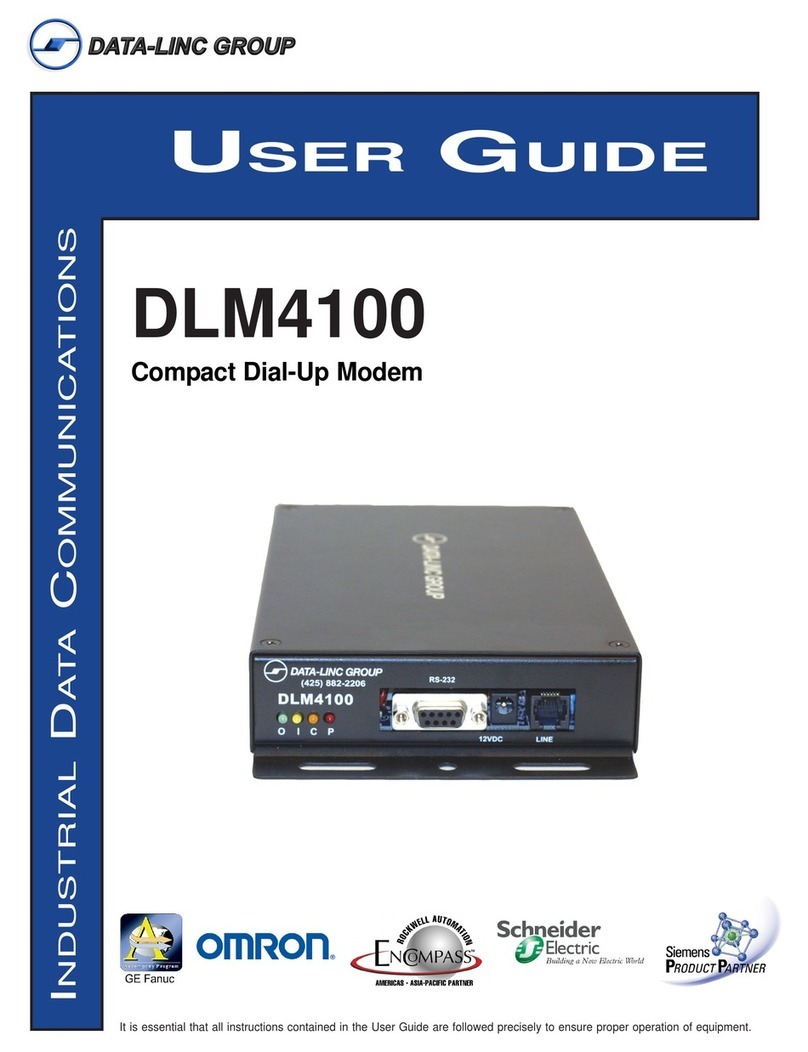
Data-Linc Group
Data-Linc Group DLM4100 User manual
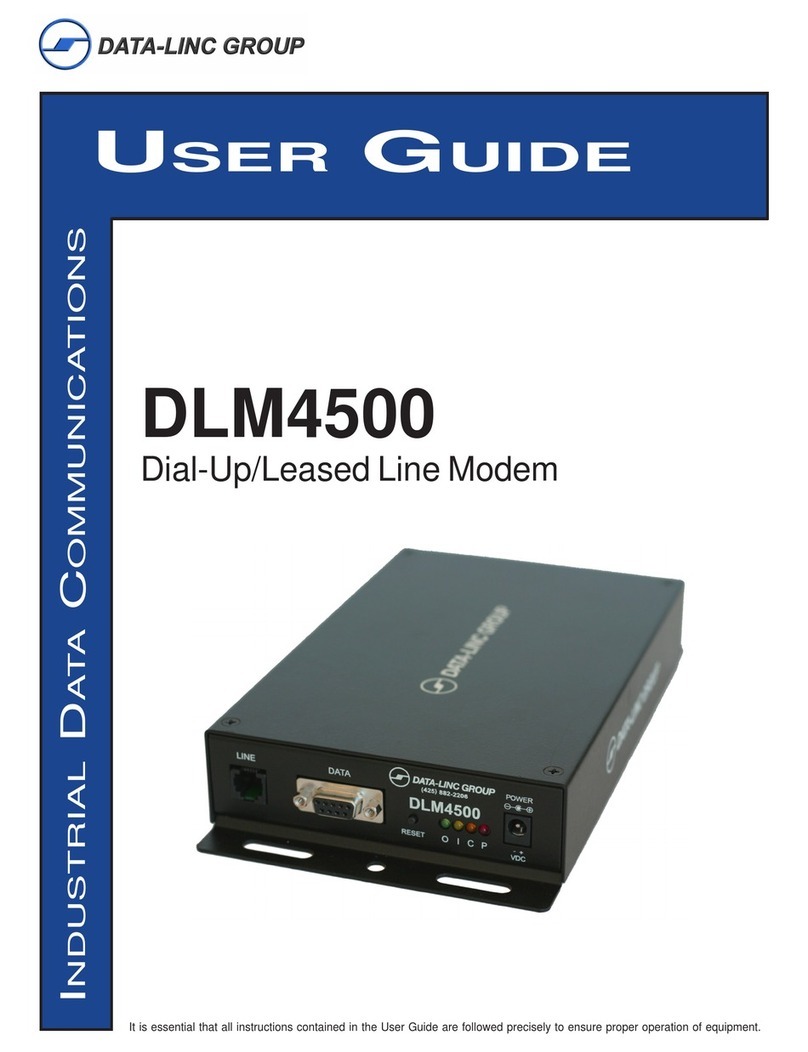
Data-Linc Group
Data-Linc Group DLM4500 User manual
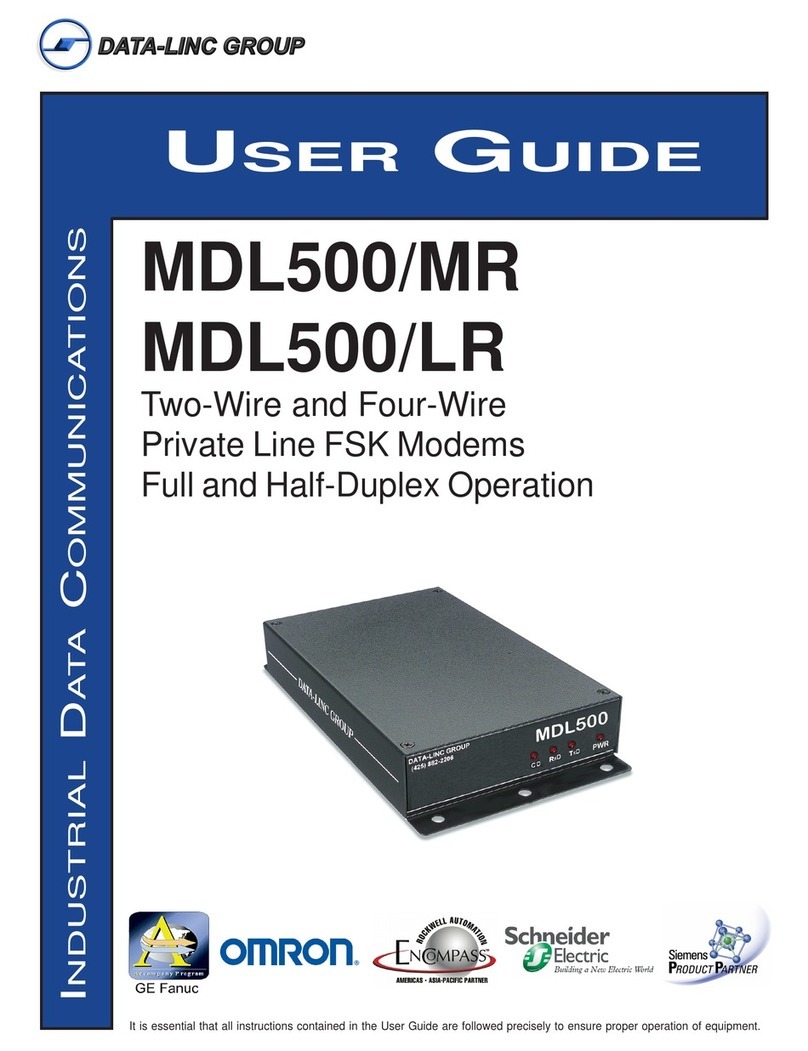
Data-Linc Group
Data-Linc Group MDL500/MR User manual
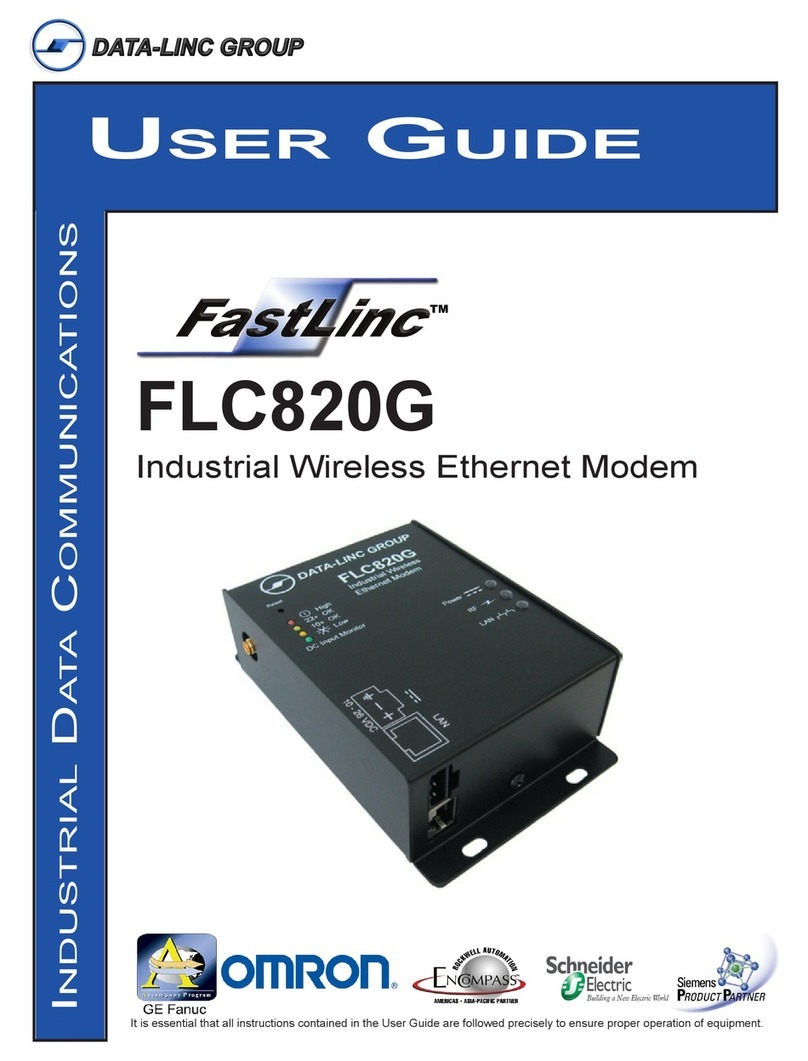
Data-Linc Group
Data-Linc Group FastLinc FLC820G User manual
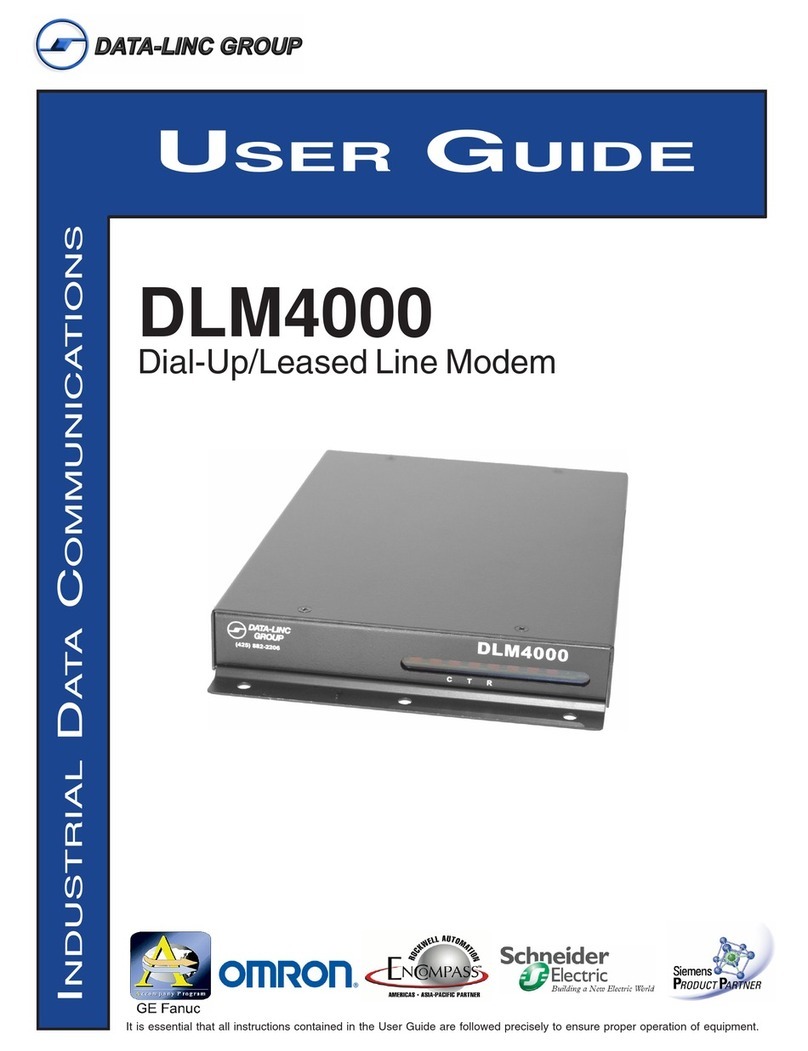
Data-Linc Group
Data-Linc Group DLM4000 User manual
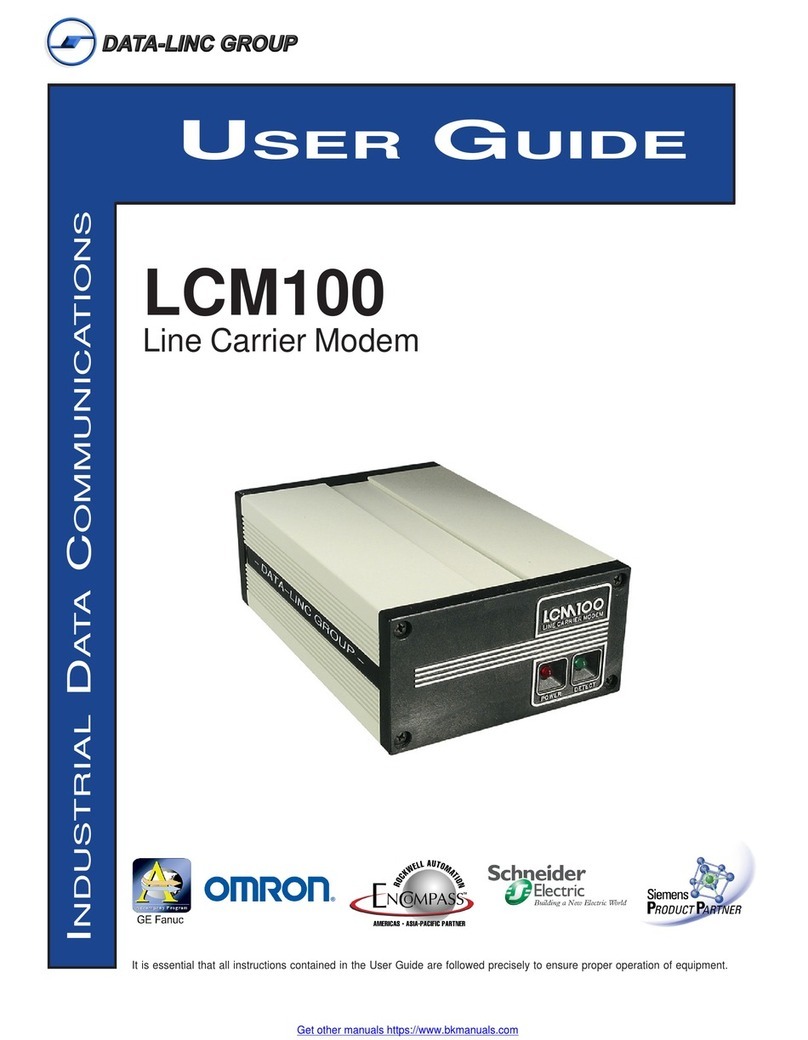
Data-Linc Group
Data-Linc Group LCM100 User manual

Data-Linc Group
Data-Linc Group FLC910E User manual
